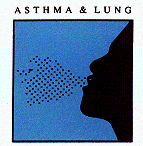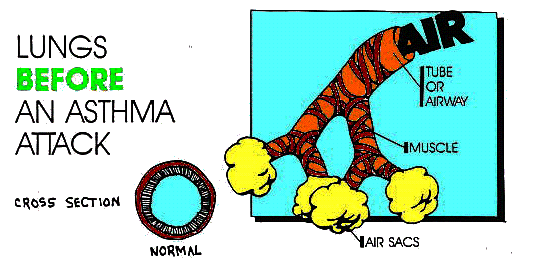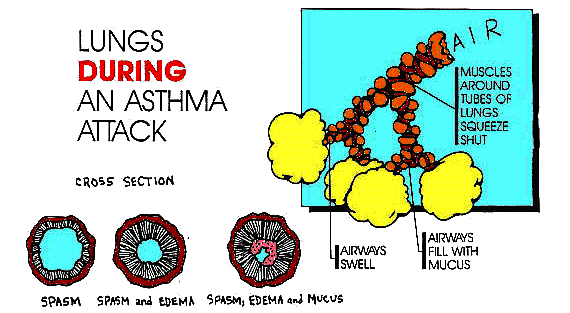

What are the causes of Asthma?
What are the Symptoms of an Asthma attack?
What Triggers an Asthma attack?

Asthma is a chronic disease of the respiratory system. All patients with Asthma have one thing in common and that is they all have trouble breathing. However, there are widely varying degrees of severity of the causes and symptoms of Asthma. Please click here to see the statistics of people who have asthma.
Asthma occurs when there is an obstruction of the bronchial airways. The airways that supply our lungs with oxygen gets narrowed, inflammed and sensitive to environmental changes. Muscus gets clogged in the airways and airway swelling contributes to disenable a person to breathe normally. Click here to understand more about the problems of the lungs.


Click here to hear how a person suffering from an asthma attack sounds like under the stethoscope.
 to Table of Contents
to Table of ContentsThe symptoms of an Asthma attack varies from person to person: however, below is a list of the most common symptoms:
 Pain in their chest
Pain in their chest
 Very heavy noisy breathing
Very heavy noisy breathing
 Coughing, wheezing
Coughing, wheezing
 Difficulty catching their breath
Difficulty catching their breath
 Trapped air in the lungs
Trapped air in the lungs
There are many different situations or habits which triggers an asthma attack. Below are some common triggers. For more information, click here.
 Allergies (eg. pollen, animals, house dust mites, etc...)
Allergies (eg. pollen, animals, house dust mites, etc...)
 Changes in the weather from mild to cold
Changes in the weather from mild to cold
 Infections (eg.colds)
Infections (eg.colds)
 Car exhaust fumes
Car exhaust fumes
 Cigarette smoke
Cigarette smoke
 Exercise
Exercise
As of today, there is no cure for asthma; however, asthma could be controlled with proper treatment. People with asthma could be relieved by taking asthma medications that are prescribed by the doctor. Usually the prescribed medications consist of drugs which could be inhaled. The purpose of inhaler medications is that it allows the minimum possible dose of the drug to be used because it will be drawn directly into the airways.
Also, people who suffers from asthma thru allergies can educate themselves on how to identify and avoid things which triggers an asthma attack. Through these treatment strategies, asthma could be managed and avoided.
 to Table of Contents
to Table of Contents


 For more information, please click on the following:
For more information, please click on the following:
 On-Line Public Access Catalog (Login asLibrary)
On-Line Public Access Catalog (Login asLibrary)
 CARL(Identify your terminal)
CARL(Identify your terminal)
 to Table of Contents.
to Table of Contents.

 The images, movies, and sounds are in courtesy of Asthma Tutorial Home Page
The images, movies, and sounds are in courtesy of Asthma Tutorial Home Page
 Heading Image is in courtesy of Asthma & Lung Specialists
Heading Image is in courtesy of Asthma & Lung Specialists
AVOID HAVING AN ASTHMA ATTACK BY LEARNING MORE ABOUT IT!!!

The following has been added by the Electronic Desktop Project:
 Contact Us
Contact UsIf you are an educator who is using our NEXTSTEP or virtual applications in the classroom, we would especially like to hear from you. Let us know what you are doing and how it is working out. Continued support for this project will depend on its impact in science education.
If you are an educator who is interested in making use of our NEXTSTEP or virtual applications, please let us know how we can help.
 Return to the Electronic Desktop Project home page
Return to the Electronic Desktop Project home page
![]() Check out the WWW Virtual Application Catalog from the EDP
Check out the WWW Virtual Application Catalog from the EDP
 Check out the NEXTSTEP Application Catalog from the EDP
Check out the NEXTSTEP Application Catalog from the EDP
 Visit the home page for California State University, Los Angeles
Visit the home page for California State University, Los Angeles